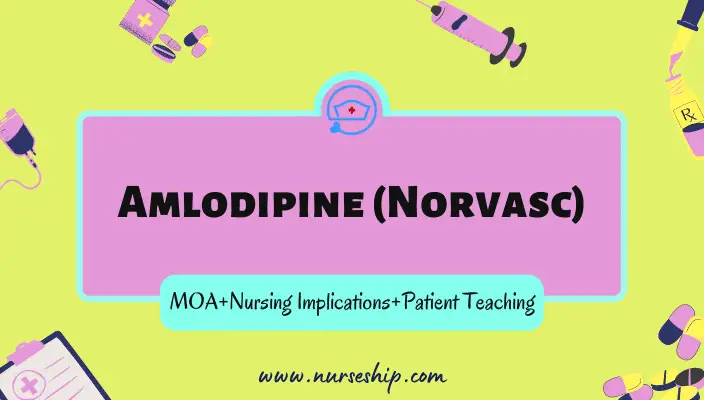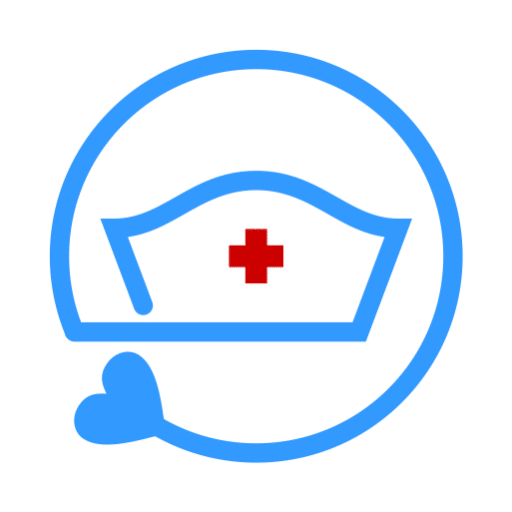Last updated on December 28th, 2023
Introduction
In this article, you’ll learn about amlodipine nursing implications and patient teachings. Also, its dosage, mechanism of action, indication, side effects.
Atorvastatin nursing implications and patient teachings
Aspirin nursing considerations and patient teachings
Generic Name: Amlodipine
Brand Name(s): Norvasc, Katerzia
Amlodipine Class and Category
Pharmacologic class: Calcium channel blocker (Dihydropyridine calcium antagonist).
Therapeutic class: Antihypertensive, antianginal
Pregnancy category: C
Amlodipine Dosage
Adults: PO: initially: 5 mg, OD; maintenance dose: 5 – 10 mg, OD; maximum dose:10 mg, OD.
Small, fragile, elderly, or hepatic insufficiency: PO: initially: 2.5 mg, OD; maintenance dose: 2.5 – 10 mg, OD.
Pediatric dose (6 years and above): PO:2.5 – 5 mg, OD.
Amlodipine Pharmacokinetics and Pharmacodynamics
| Route | Onset | Peak | Duration |
| PO | 0.5 – 1 hour | 6 – 12 hours | 24 hours |
Absorption: Slow absorption from the GI tract.
Distribution: Protein binding is more than 93%.
Metabolism: Hepatic.
Half-life: 30 – 50 hours (increased in elderly and patients with hepatic insufficiency).
Excretion: Mainly excreted via urine.
Amlodipine Mechanism of Action
Amlodipine inhibits the influx of extracellular calcium ions across slow calcium channels by binding to dihydropyridine and non-dihydropyridine cell membrane receptor sites on cardiac and vascular smooth muscle cells.
This lowers intracellular calcium levels, preventing smooth-muscle cell contractions and relaxing coronary and vascular smooth muscles.
As a result, the therapeutic effects are as follows.
- Decreases both systolic and diastolic blood pressure.
- Decreases peripheral vascular resistance by dilating coronary arteries and restoring blood flow. This lowers myocardial workload, oxygen demand, and vasospastic angina.
What are the indications of Amlodipine?
Amlodipine indications include:
- To treat hypertension in adults and children above 6 years.
- To treat coronary artery diseases (CAD), such as;
- Chronic stable angina
- Vasospastic angina (Prinzmetal’s or variant angina)
- Angiographically documented coronary artery disease (CAD) without heart failure or an ejection fraction more than 40%.
What are the contraindications of Amlodipine?
The contraindications of amlodipine are:
- Hypersensitivity to amlodipine and its components.
Caution: Hepatic impairment; severe aortic stenosis; severe obstructive coronary artery disease.
Amlodipine Interactions
- Amlodipine effect is increased when take with moderate and strong CYP3A4 (such as ketoconazole, itraconazole, ritonavir).
- Amlodipine may increase plasma levels of cyclosporine, simvastatin, and tacrolimus.
- Concomitant use of ACE inhibitors may increase risk of hyperkalemia, hypotension, and renal dysfunction in patients with renal disease and diabetes.
- Concomitant use of Sildenafil may result in severe hypotension.
Lab interactions
- Amlodipine may increase LFTs.
Herbal/food interactions
- Not known.
What are amlodipine side effects?
Amlodipine side effects / adverse reactions include:
- Peripheral edema
- Headache
- Flushing
- Dizziness
- Palpitations
- Asthenia
- Nausea
- Fatigue
- Lethargy
- Abdominal pain
- Somnolence
- Constipation/ diarrhea
- Sexual dysfunction
- Myalgia
- Arthralgia
- Dry mouth
- Insomnia
- Nervousness
- Abnormal dreams
- Paresthesia
- Tremor
- Vertigo
Life-threatening adverse effects include:
- Angioedema
- Cardiac failure
See also:
Atorvastatin nursing implications and patient teachings
Aspirin nursing considerations and patient teachings
Amlodipine Nursing Implications [Nursing Considerations]
Amlodipine nursing implications are divided into nursing assessment, interventions, and evaluation.
Amlodipinenursing assessment
- Obtain comprehensive medical and family history.
- Obtain baseline vital signs including apical pulse and ECG.
- Assess anginal pain (onset, intensity, location, duration of pain, characteristics, aggravating and relieving factors).
- Assess fluid volume status and signs of heart failure (such as breathing difficulty, peripheral edema, jugular vein distention, crackles).
- Obtain baseline LFTs and RFTs.
Amlodipine nursing diagnosis
- Acute pain (indication).
- Risk for decreased cardiac output (indication).
- Activity intolerance (indication).
Amlodipine nursing interventions/ actions
- Monitor blood pressure and apical pulse. Withhold amlodipine and notify the physician if systolic blood pressure is less than 90 mmHg.
- Monitor for adverse effects of amlodipine such as headache, dizziness, asthenia, hot flush, peripheral edema.
- Amlodipine effect increases when administered with strong CYP3A4 (such as ketoconazole, itraconazole, ritonavir). Observe for signs of hypotension and edema in patient taking both medications.
- Monitor blood levels of cyclosporine and tacrolimus when amlodipine is co-administered. Because this may increase plasma levels of those drugs and dose adjustments are needed.
- Closely monitor patients with severe obstructive coronary artery disease for worsening of angina and sudden onset of myocardial infarction at the beginning and increasing dosage during amlodipine therapy.
- Observe for symptomatic hypotension in patient with severe aortic stenosis.
- Teach the patient how to monitor blood pressure and pulse at home.
Evaluation
Evaluate the effectiveness of amlodipine:
- For reduced blood pressure within desired limits.
- For reduced anginal pain.
- For improved activity tolerance.
- For absence of side effects.
- For adherence to treatment regimen.
Pregnancy/breastfeeding considerations for amlodipine
- It is unknown whether amlodipine can harm the fetus. Use only after consulting with physician during pregnancy.
- It is unknown whether amlodipine excretes in the breastmilk. Consult a doctor before starting lactation.
What is the patient teaching for amlodipine?
The nursing patient teaching for amlodipine should include the following points.
- Instruct the patient/family take medicine as prescribed and not to stop amlodipine abruptly or when feeling better.
- Tell patient to take amlodipine with food to avoid GI upset.
- Emphasis on the importance of adhering to treatment regimen to control blood pressure as well as modifying lifestyle (e.g., diet, exercise, smoking cessation, stress reduction).
- Teach the patient adverse effects of amlodipine and when to notify the prescriber.
- Advice patient to check blood pressure regularly and to keep a record.
- Instruct the patient to change position slowly to avoid orthostatic hypotension.
- Advise the patient to avoid hazardous activities that require alertness and motor skills until the drug’s response is established.
- Instruct patient to avoid OTC medicine without physician’s direction.
Treatment of Overdose
- Defibrillation
- Beta agonists
- IV calcium inotropic agents
- Diuretics
- Atropine for AV block
- Vasopressor for hypotension
- Active cardiac and respiratory monitoring.
- Monitor urine output and fluid status.
- Provide cardiovascular support.
Related posts:
Atorvastatin nursing implications and patient teachings
Aspirin nursing considerations and patient teachings
Conclusion
You learned about amlodipine nursing implications and patient teaching in this article. In addition, you’ve learned about amlodipine’s mechanism of action, pharmacokinetics, dosage, indications, contraindications, and side effects.
Recommended Readings & Reference
FDA Norvasc (Amlodipine Besylate) information
FDA Katerzia (amlodipine) information
Kee, J., Hayes, E., & McCuistion, L. (2015). PHARMACOLOGY A Patient-Centered Nursing Process Approach (8th ed.). Elsevier Inc/Saunders.
Kizior, R., & Hodgson, K. (2021). SAUNDERS NURSING DRUG HANDBOOK 2021. Elsevier Inc.
Jones & Bartlett Learning. (2021). Nurse’s Drug Handbook (20th ed.). Jones & Bartlett Learning, LLC.
Skidmore-Roth, L. (2021). MOSBY’S 2021 NURSING DRUG REFERENCE (34th ed.). Elsevier Inc.


